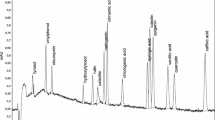Abstract.
Hydrophilic phenols are the most abundant natural antioxidants of virgin olive oil (VOO), in which, however, tocopherols and carotenes are also present. The prevalent classes of hydrophilic phenols found in VOO are phenolic alcohols and acids, flavonoids, lignans and secoiridoids. Among these substances the last two classes include the most concentrate phenols of VOO. Secoiridoids, like aglycone derivatives of oleuropein, demethyloleuropein and ligstroside, are present in olive fruit as most abundant VOO phenolic antioxidants. Several important biological properties (antioxidant, anti-inflammatory, chemopreventive and anti-cancer) and the characteristic pungent and bitter tasty properties have been attributed to VOO phenols. Relationships between polyphenols activities and their chemical structures are discussed in this paper.
Similar content being viewed by others

Author information
Authors and Affiliations
Additional information
Received 15 April 2008; accepted 7 November 2008
Rights and permissions
About this article
Cite this article
Servili, M., Esposto, S., Fabiani, R. et al. Phenolic compounds in olive oil: antioxidant, health and organoleptic activities according to their chemical structure. Inflammopharmacol 17, 76–84 (2009). https://doi.org/10.1007/s10787-008-8014-y
Published:
Issue Date:
DOI: https://doi.org/10.1007/s10787-008-8014-y



